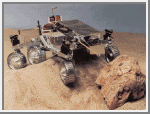















|
NASA Mars Probe
Courtesy of NASA's National Space Science Data Center
The Mars Pathfinder (formerly known as the Mars Environmental Survey, or MESUR, Pathfinder) will be the second of NASA's low-cost planetary Discovery missions. The mission will consist of a stationary lander and a surface rover. The mission has the primary objective of demonstrating the feasibility of low-cost landings on and exploration of the Martian surface. This objective will be met by tests of communications between the rover and lander, and the lander and Earth, and tests of the imaging devices and sensors. The spacecraft will be launched in December 1996 for an arrival on Mars in July 1997.
The scientific objectives include atmospheric entry science, long-range and close-up surface imaging, with the general objective being to characterize the Martian environment for further exploration. The spacecraft is scheduled to enter the Martian atmosphere without going into orbit around the planet and land on Mars with the aid of parachutes, rockets and airbags. Mars Pathfinder will take atmospheric measurements on the way down. Prior to landing, the spacecraft will be enclosed by three triangular solar panels (petals), which will unfold onto the ground after touchdown.
 The rover, named "Sojourner" (previously known as Rocky IV), is a six-wheeled vehicle. It will be controlled by an Earth-based operator, who will use images obtained by both
the rover and lander systems. Note that the time delay will be between 6 and
41 minutes depending on the relative position of Earth and Mars, requiring
some autonomous control by the rover. The primary objectives are scheduled
for the first seven sols, all within about 10 meters of the lander. The
extended mission will include longer trips away from the lander over about
30 sols. A landing site has been chosen for the Mars Pathfinder in the Ares Vallis
area.
The rover, named "Sojourner" (previously known as Rocky IV), is a six-wheeled vehicle. It will be controlled by an Earth-based operator, who will use images obtained by both
the rover and lander systems. Note that the time delay will be between 6 and
41 minutes depending on the relative position of Earth and Mars, requiring
some autonomous control by the rover. The primary objectives are scheduled
for the first seven sols, all within about 10 meters of the lander. The
extended mission will include longer trips away from the lander over about
30 sols. A landing site has been chosen for the Mars Pathfinder in the Ares Vallis
area.